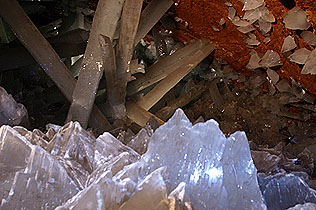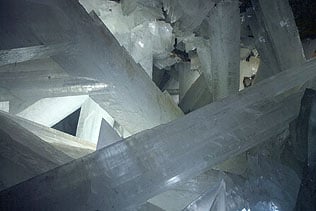|
Inside of the cave with giant, 11-meter-long crystals. |
Inside of the crystal cave. |
Mexico has a great number of caves of unique characteristics, such as the Crystals’ Cave containing the largest natural crystals on earth, formed by hydrothermal fluids emanating from the magma chambers deep below. Crystals measuring up to 12 m and weighing up to 55 tons are found at -300 m at Naica Mountain in the Chihuahua dessert. Candles’ Cave growing unusually beautiful crystals, and Queen’s Eye Cave, a geode like chamber are also found at Naica . Other impressive caves housing colonies of hundreds of thousands of bats are found in Nuevo Leon and Campeche. The Suchiooc lava tube caves in Morelos, are about 25 kms long, distributed in about 20 different caves. Two of them, Ferrocarril and la Iglesia contain some of the largest lava tubes in the American Continent. |
| Diving caves are the most popular destinations. The typical karst cave environment encountered in the Yucatan peninsula is marked by shallow depths, extensive passageways, speleothems, warmer water and multiple entries called “cenotes”. Maze-like cave systems with restricted areas and tunnels, challenge even the most experienced diver. |
The world famous Sótano de las Golondrinas is found in San Luis Potosí. It has a free-fall of 376 m. Each morning thousands of swallows swirl-up inside the sotano to come out cutting the wind at great speed. After them several groups of brilliant green parrots follow giving a great spectacle of color. In the afternoon a black river in the sky is seen from afar. The swallows return at 120 kms per hour and birds of pray wait for their dinner. La Lucha and La Fosa de las Cotorras in Chiapas are well known but the deepest in the country is el Sotano del Barro en Queretaro with a depth of 450 m. There are at least nine caves in Mexico more than 1000 m deep. The Cheve system is the deepest cave in the American Continent. The Cuetzalan system in Puebla and the Purificación in Tamaulipas are real labyrinths. You enter in one side and come out in the other end, generally following a water current. |
|
|
There are caves formed by underground rivers like Chontalcoatlan, San Jerónimo and the more challenging Acahuizotla in Guerrero and el Chorreadero in Chiapas. In contrast, there are two spectacular fossil caves, now tourist attractions like Grutas de Cacahuamilpa and Juxtlahuaca in the State of Guerrero. |



